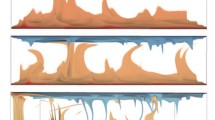Abstract
We have developed a simple, steady-state, one-dimensional second-order closure model to obtain continuous profiles of turbulent fluxes and mean concentrations of non-conserved scalars in a convective boundary layer without shear. As a basic tool we first set up a model for conserved species with standard parameterizations. This leads to formulations for profiles of the turbulent diffusivity and the ratio of temperature-scalar covariance to the flux of the passive scalar. The model is then extended to solving, in terms of profiles of mean concentrations and fluxes, the NO x –O3 triad problem. The chemical reactions involve one first-order reaction, the destruction of NO2 with decay time τ, and one second-order reaction, the destruction of NO and O3 with the reaction constant k. Since the fluxes of the sum concentrations of NO x = NO + NO2 and O3 + NO2 turn out to be constant throughout the boundary layer, the problem reduces to solving two differential equations for the concentration and the flux of NO2. The boundary conditions are the three surface fluxes and the fluxes at the top of the boundary layer, the last obtained from the entrainment velocity, and the concentration differences between the free troposphere and the top of the boundary layer. The equations are solved in a dimensionless form by using 1/(kτ) as the concentration unit, the depth h of the boundary layer as the length unit, the convective velocity scale w * as the velocity unit, and the surface temperature flux divided by w * as the temperature unit. Special care has been devoted to the inclusion of the scalar–scalar covariance between the concentrations of O3 and NO. Sample calculations show that the fluxes of the reactive species deviate significantly from those of non-reactive species. Further, the diffusivities, defined by minus the flux divided by the concentration gradient may become negative for reactive species in contrast to those of non-reactive species, which in the present model are never negative.
Similar content being viewed by others
References
André JC, Moor GD, Lacarrère P, Vachat RD (1976) Turbulent approximation for inhomogeneous flows: part 2. The numerical simulation of a penetrative convection experiment. J Atmos Sci 33: 482–491
Busch NE (1973) On the mechanics of atmospheric turbulence. In: Haugen DA (eds) Workshop on micrometeorology. American Meteorological Society, Boston, 392 pp
Gryning SE, Batchvarova E (1994) Parameterization of the depth of the entrainment zone above the daytime mixed layer. Q J Roy Meteorol Soc 120: 47–58
Hargreaves KJ, Fowler D, Storeton-West RL, Duyzer JH (1992) The exchange of nitric oxide, nitrogen dioxide and ozone between pasture and the atmosphere. Environ Pollut 75: 53–59
Holtslag AAM, Moeng C (1991) Eddy diffusivity and countergradient transport in the convective atmospheric boundary layer. J Atmos Sci 48: 1690–1698
Isserlis L (1918) On a formula for the product-moment coefficient in any number of variables. Biometrika 12: 134–139
Kristensen L, Kirkegaard P (2006) Fluxes and concentrations of non-conserved scalars in the atmospheric surface layer, second-order destruction. J Atmos Chem 53: 251–283
Kristensen L, Andersen CE, Jørgensen HE, Kirkegaard P, Pilegaard K (1997) First-order chemistry in the surface-flux layer. J Atmos Chem 27: 249–269
Leighton PA (1961) Photochemistry of air pollution. Academic Press, New York, 300 pp
Lenschow DH, Delany AC (1987) An analytic formulation of NO and NO 2 flux profiles in the atmospheric surface layer. J Atmos Chem 5: 301–309
Lenschow DH, Wyngaard JC, Pennell WT (1980) Mean-field and second-moment budgets in a baroclinic, convective boundary layer. J Atmos Sci 37: 1314–1326
Moeng C, Wyngaard JC (1986) An analysis of closures for pressure-scalar covariances in the convective boundary layer. J Atmos Sci 43: 2499–2513
Moeng C, Wyngaard JC (1989) Evaluation of turbulent transport and dissipation closures in second-order modelling. J Atmos Sci 46: 2311–2330
Ridley BA, Madronich S, Chatfield RB, Walega JG, Shetter RE, Carrol MA, Montzka DD (1992) Measurements and model simulations of the photostationary state during the Mauna-Loa-observatory photochemistry experiment—implications for radical concentrations and ozone production and loss rates. J Geophys Res 97(D10): 10375–10388
Tennekes H (1973) A model for the dynamics of the inversion above a convective boundary layer. J Atmos Sci 30: 558–567
Verver GHL, van Dop H, Holtslag AAM (1997) Turbulent mixing of reactive gases in the convective boundary layer. Boundary-Layer Meteorol 85: 197–222
Verver GHL, van Dop H, Holtslag AAM (2000) Turbulent mixing and the chemical breakdown of isoprene in the atmospheric boundary layer. J Geophys Res 105: 3983–4002
Wolfram S (1999) The mathematica book, 4th edn. Wolfram Media/Cambridge University Press, Champaign/Cambridge, 1470 pp
Wyngaard JC (1982) Boundary-layer modeling. In: Nieuwstadt FTM, van Dop H (eds) Atmospheric turbulence and air pollution modeling, chap 3. D. Reidel, Dordrecht, pp 69–106
Wyngaard JC, Brost RA (1984) Top-down and bottom-up diffusion of a scalar in the convective boundary layer. J Atmos Sci 41: 102–112
Author information
Authors and Affiliations
Corresponding author
Additional information
An erratum to this article can be found at http://dx.doi.org/10.1007/s10546-010-9473-4
Rights and permissions
About this article
Cite this article
Kristensen, L., Lenschow, D.H., Gurarie, D. et al. A Simple Model for the Vertical Transport of Reactive Species in the Convective Atmospheric Boundary Layer. Boundary-Layer Meteorol 134, 195–221 (2010). https://doi.org/10.1007/s10546-009-9443-x
Received:
Accepted:
Published:
Issue Date:
DOI: https://doi.org/10.1007/s10546-009-9443-x




